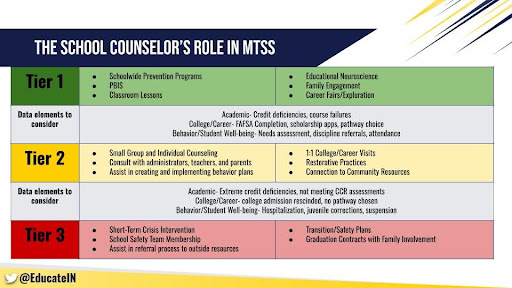 The role of a school counselor is to ensure they are providing a data-driven counseling program that supports and addresses the needs of all of the students they serve. One of the most effective ways to do so is by implementing the MTMDSS Framework. Multi-tiered, multi-domain systems of support (MTMDSS) is a framework which allows school counselors to deliver their programming in a tiered approach to ensure they are meeting the needs of students in multiple domains: student well-being, academics, behavior/attendance and college/career.
The role of a school counselor is to ensure they are providing a data-driven counseling program that supports and addresses the needs of all of the students they serve. One of the most effective ways to do so is by implementing the MTMDSS Framework. Multi-tiered, multi-domain systems of support (MTMDSS) is a framework which allows school counselors to deliver their programming in a tiered approach to ensure they are meeting the needs of students in multiple domains: student well-being, academics, behavior/attendance and college/career.
The ultimate goal is for schools to have their MTMDSS programs resemble a pyramid, where all of their students in tier 1 are being provided evidenced based curriculum, with some (20%) of their students receiving tier 2 targeted interventions, and a few (5-10%) of their students receiving tier 3 intensive services. We often see schools operating in an inverted pyramid, where more than half of their students are in need of receiving tier 2 and 3 services, which can cause a strain on capacity and resources. A school counseling program that uses the MTMDSS framework can help schools build a solid foundation so fewer students need more intensive services over time.
“A school counseling program that uses the MTMDSS framework can help schools build a solid foundation so fewer students need more intensive services over time.”
What is the role of a school counselor in MTMDSS?
A comprehensive school counseling program should be driven by data measures. School counselors should analyze student outcomes such as attendance, discipline or academic data, to determine the greatest needs of their students. Schools can also use other sources of data collection such as a needs assessment (a survey completed by students, parents, teachers, and/or administrators that offers a data-informed direction for programming). Once the data has been gathered, school counselors can create an action plan and use data to monitor progress.

Breaking down the Tiers
Data driven comprehensive school counseling programs support ALL students by shifting the emphasis to providing robust evidence based Tier 1 supports. Tier 1 supports are district and school wide programs, activities and curriculum that benefit all students. Some examples of this are skill-building classroom lessons, mindfulness activities, career exploration and school-wide prevention programs.
Tier 2 are more targeted interventions that are progress monitored for students who are identified as needing additional support. In elementary schools, counselors may use attendance data to identify students who may benefit from a small group around time management. In high school, counselors may notice students who have credit deficiencies and consult with teachers and administrators to create academic success plans for those specific students. These students are then monitored, and if they do not make progress, they may be referred on for more intensive support.
Tier 3 is an intensified support often provided after other interventions have failed, or after a crisis or emergency. School counselors may provide individualized 1:1 counseling, refer students to outside services, help provide safety or transition plans or work with students and their families to improve student outcomes. In elementary school, a student who is having significant behavioral issues might be referred to a school-based mental health therapist for further evaluation. In high school, a student who is having serious attendance issues because they are caring for a sibling and are at risk of not graduating from high school may be referred for a mentorship program that provides the family with more wrap-around support to insure the student is able to attend school.
Using the MTMDSS framework, school counselors can ensure they are serving their students most efficiently by providing robust, evidence-based tier 1 programming which allows counselors more time with ALL students they serve. When counselors create programming each year that meets specific needs of the current students, this may prevent students from needing tier 2 and tier 3 interventions down the line and improve school counselor capacity.
“When counselors create programming each year that meets specific needs of the current students, this may prevent students from needing tier 2 and tier 3 interventions down the line and improve school counselor capacity.”
Would you like to learn more about MTMDSS?
Are you wondering how you can start implementing the MTMDSS framework in your school or school counseling program? Dive deeper into learning about MTMDSS and the role of the school counselor with our one page MTMDSS DIY guide which has many clickable links. Counselor Connect will provide additional DIY guides featuring specific grade level MTMDSS Interventions, and organization of Tier 2 and 3 interventions this Spring.
Resources
Please login or register to claim PGPs.
Alternatively, you may use the PGP Request Form if you prefer to not register an account.



